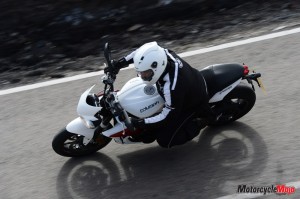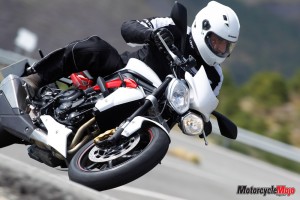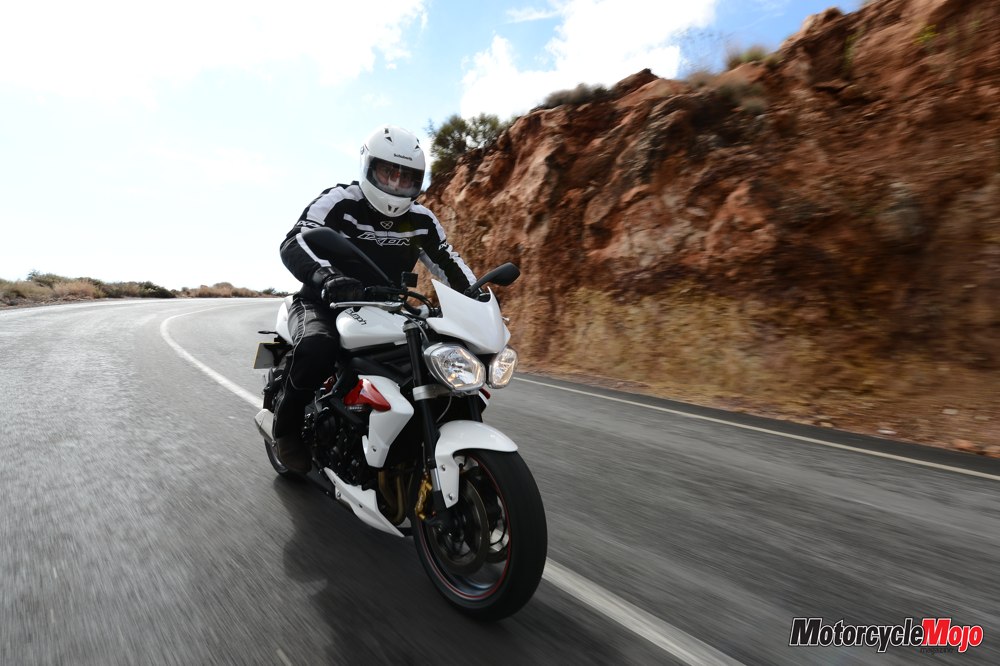Triumph’s 675 cc, inline-triple is one of my favourite motorcycle engines. It has big, V-twin–like mid-range torque, power pulses as smooth as a four, and its power band is wide enough that it can also serve well in a supersport chassis, as it does in the Daytona 675. It also emits that alluring triple-cylinder growl, providing an altogether captivating combination. I feel the engine’s best application, however, is in the Street Triple 675, introduced in 2007. This middleweight, naked roadster immediately struck a chord with riders, offering a better balance than the similarly styled Speed Triple 1050, but in a very accessible price bracket. The recently revised 2013 model starts at just $9999.
Triumph invited Motorcycle Mojo to Almería, Spain, to ride the latest iteration of what has become the firm’s most popular bike. More than 50,000 Street Triples have been sold worldwide in the five years since its introduction, making it the best-selling bike produced by the Hinckley factory during that time. No one was complaining about the bike as originally designed, but engineers went ahead and refreshed it just the same, and for 2013, it receives more than just a facelift.
Slightly sharper lines define the new Street Triple, and there’s now a plastic shroud covering the radiator, giving the bike a more finished look. Immediately noticeable is the exhaust pipe, which has migrated from under the seat (where no proper exhaust should be, really) to beneath the bike, exiting on the right-hand side. This gives the bike a more compact rear end, while chopping 3.6 kg of weight and moving weight closer to the bike’s centre of gravity. The new bike has seen a total weight reduction of 6 kg (13 lb.), now tipping the scales at 183 kg (403 lb.) wet, with ABS. With the relocation of the exhaust, there’s now room under the seat for a full-size D-lock, and there’s even a channel moulded into the underseat compartment to hold it in place.
 The new Street Triple isn’t just about a new look; it has received chassis upgrades too. A new frame is now comprised of eight pieces instead of the former bike’s 11 pieces, and it has been reshaped about the steering neck to provide three additional degrees of steering lock, permitting the fork to swing 31 degrees from lock to lock. It doesn’t sound like much, but it does make U-turns much easier to complete.
The new Street Triple isn’t just about a new look; it has received chassis upgrades too. A new frame is now comprised of eight pieces instead of the former bike’s 11 pieces, and it has been reshaped about the steering neck to provide three additional degrees of steering lock, permitting the fork to swing 31 degrees from lock to lock. It doesn’t sound like much, but it does make U-turns much easier to complete.
Most of the removed weight has come from the rear (and in the exhaust system’s case, from up high), with a lighter rear subframe, rear caliper and disc combination, and new, lighter, five-spoke wheels. These lighter components have reshuffled the weight distribution, and there’s now a 52/48 percent front-to-rear bias, which puts more weight over the front tire than the previous bike’s 49/51 percent. The new rear wheel, disc and caliper also contribute to a seven percent decrease in rear unsprung weight, which improves suspension response. Steering geometry has been altered slightly, with a slightly steeper rake angle and a touch more trail. The standard Street Triple and the R model have slightly different chassis specs, but each machine has had similar chassis changes.
Looking at the spec sheet, there doesn’t seem to be a lot new happening with the engine, and output is identical at 105 hp and 50 ft-lb of torque. However, there are a couple of minor changes, starting with a taller first gear, which narrows the gap to second gear and helps the bike to jerk less at low speeds. This makes it a bit more rider friendly in town.
Another change is in how the throttle works. The mechanical ratio between the throttle grip and throttle bodies has been altered, mostly to improve fuel efficiency. Throttle action is now more progressive, a change that would normally soften throttle response at low revs. To compensate for this, ignition timing has been advanced at low engine speeds, which improves fuel economy by 30 percent around town and 12 percent at 90 km/h, while providing a negligible difference in throttle response at low speeds compared to the old bike. Topping off the engine changes is a redesigned airbox that produces a more pronounced intake howl. And finally, both the standard and R models have been prewired to accept Triumph’s optional “Intellishift” quick shifter, which allows you to shift gears without closing the throttle or pulling the clutch.
 Our test bikes were all the $11,199 Street Triple R models, equipped with fully adjustable suspension and radial-mount, four-piston front brake calipers. The bike I rode was a non-ABS model, but all Street Triples coming to North America, including the R models, will be ABS equipped. There shouldn’t be much difference in brake feel or power between ABS and non-ABS models. On the R, this was supersport-precise, with strong initial bite and light, yet easily modulated lever effort. Curiously, Street Triples use Nissin front calipers and a Brembo rear caliper, though this is probably because of the newly sourced, smaller and lighter rear caliper.
Our test bikes were all the $11,199 Street Triple R models, equipped with fully adjustable suspension and radial-mount, four-piston front brake calipers. The bike I rode was a non-ABS model, but all Street Triples coming to North America, including the R models, will be ABS equipped. There shouldn’t be much difference in brake feel or power between ABS and non-ABS models. On the R, this was supersport-precise, with strong initial bite and light, yet easily modulated lever effort. Curiously, Street Triples use Nissin front calipers and a Brembo rear caliper, though this is probably because of the newly sourced, smaller and lighter rear caliper.
The standard Street Triple uses a non-adjustable fork, a shock adjustable only for preload, and twin-piston front calipers. There are also some visual differences distinguishing the R from the standard bike, including red side covers over the radiator, a red sub-frame and red pinstriping on the wheel rims. Of special note on the bike I rode were some added accessories, including crash bars, a flyscreen, a belly pan, a couple of anodized covers, and tiny LED turn signals, which I was told have not yet been approved for North America, so we won’t get them here.
The Street Triple has one unmistakable quality: no matter what your riding background, chances are that you’ll like it as soon as you let the clutch out the first time. This redeeming quality has transferred to the latest model. Seating is relaxed and upright, and the foot pegs fall somewhere between an adventure-touring bike and full-on supersport.
Once fired, the bike immediately vies for your affection with its tempting exhaust growl, which is accentuated, when you open the throttle wide, by the renewed intake snarl. First gear is, indeed, taller than before, and you need to slip the clutch a bit to get going, though the torquey engine easily handles the extra load. First gear is now good for about 50 km/h before a shift to second is needed. This makes the bike easier to handle at low speeds, though you also have to work the clutch a bit more when crawling about at parking-lot speeds.
Clutch effort is light and gearbox action solid and precise. One of the machines I rode was equipped with the optional quick shifter. The quick shifter uses a switch on the shift lever to momentarily cut the ignition to allow clutchless shifting. The engine control module has been programmed to alter the amount of time that the ignition is cut, so that the quick-shifter can be used at various throttle openings, and not just when it’s held wide open, like on a race bike. This made upshifting quite convenient, working very much like a semi-automatic transmission, allowing clutchless gear changes at all speeds, though downshifting still required the clutch. Even though there was no need to roll off the throttle when using the quick shifter, on/off throttle response seemed smoother than on the previous bike, though only a back-to-back comparison will confirm this.
Winding roads took us north out of Almería and into the mountains. Southern Spain is arid, very similar to southern California in its geographical features. This is why filmmaker Sergio Leone chose the area to film several of his masterful spaghetti westerns. The Street Triple was also in its natural setting here, effortlessly handling the tight, winding Spanish roads and returning a very gratifying riding experience. Even though this was prime sportbike territory, the Street Triple was a much better fit, providing the same sharp handling, but in a much more comfortable package.
The engine pulls hard regardless of revs, and if you’re too lazy to shift, you can lug it smoothly in top gear at speeds as low as 60 km/h. The flexible power band allows you to either leave the bike in one gear (like I did, in fourth, through the tighter sections of the roads north of Almería) or click up and down a couple of gears if you have a busy left foot. Either way you choose to ride it, the Street Triple accelerates with enthusiasm.
We were told that the combination of lighter weight and more forward-biased weight distribution has quickened turning transitions compared to the old bike, but again, a ride on the two machines will be needed to validate this claim.
What I can say is that the Street Triple R handles neutrally and with accuracy, forgiving overly ambitious corner entry by responding to mid-turn braking without standing up. It trail-brakes effectively without running wide into turns and exhibits excellent stability at speed and through sweepers despite its wide-ish upright handlebar. In other words, it’s hard to fault its handling. Initially, my bike was a bit soft in the rear, wallowing just a touch through some of the faster corners, so during a lunch break, I cranked three clicks of rebound damping into the shock and immediately felt a difference on the fast, winding road we took to return to our hotel. The bike railed along through the fast, sweeping turns in a constant, undisturbed arc. Unfortunately, I can’t comment on the standard Street Triple’s handling, as there weren’t any available for testing.
Before arriving at the hotel, we took a detour to a nearby attraction called Mini Hollywood. We discovered that this mock-up of an Old West U.S. town – complete with general store, post office and jail – is a tourist attraction that even puts on daily “Wild West” shows. It was originally built in the mid-1960s as the set for Leone’s classic Clint Eastwood flick, The Good, The Bad and The Ugly.
We thought it would be a great idea to get a bike or two onto the western-style set for a couple of unique photos among its wooden buildings and dirt roads, but alas, we couldn’t get any closer than the parking lot. It seems that although the primary purpose for this oddly located western town is to entertain visiting families, it is still used as a film set. On the day we arrived, a film crew was using it, so we weren’t allowed in. We weren’t too disappointed as we headed out, because we still had several kilometres of winding roads before reaching our hotel and parking the bikes.
The Street Triple’s closest rival is the BMW F800R; with the ABS option, the BMW is priced closer to the Street Triple R and it weighs about the same, though the Triumph has the edge on horsepower, pumping out about 20 more ponies despite its smaller engine displacement. The Street Triple is a more muscular and raw, hooligan-like machine, whereas the F800R has a slightly more civilian demeanour, despite what stunt rider Chris Pfeiffer has been seen doing on the machine.
A ride on the standard Street Triple would have revealed if the R is worth the extra $1,200, though I wouldn’t hesitate to dish out the extra cash for the sportier R and its fully adjustable suspension, especially considering the price of an aftermarket shock alone these days.
I was fond of the Street Triple when it was first introduced, and considered it among my top five favourite motorcycles. The numerous changes haven’t completely transformed the new Street Triple, though they have made a great bike even better, and it certainly retains its spot among my top favourites.
| The Basics | |
| LIST PRICE | $9999 / $11,199 |
| WARRANTY | 2 years, unlimited mileage |
| COMPANY URL | www.triumph-motorcycles.ca |
| The drivetrain | |
| ENGINE TYPE | Liquid-cooled inline-triple |
| DISPLACEMENT | 675 cc |
| POWER | 78kW (105 hp) at 11,850 rpm |
| TORQUE | 68N-m (50 ft-lb) at 9750 rpm |
| BORE AND STROKE | 74 x 52.3 mm |
| COMPRESSION RATIO | 12.85:1 |
| FUEL DELIVERY | Electronic fuel injection |
| TRANSMISSION | Six-speed |
| FINAL DRIVE TYPE | O-ring chain |
| The Essentials | |
| FRONT SUSPENSION | Standard: 41 mm inverted fork, non adjustable. |
| R-model: adjustable preload, compression and rebound damping | |
| REAR SUSPENSION | Standard: Monoshock, adjustable preload |
| R-model: Monoshock with piggy back reservoir, adjustable rebound and compression damping | |
| WHEEL TRAVEL | Standard: Front: 110 mm (4.3 in.). Rear: 125 mm (4.9 in.) |
| R-model: Front: 115 mm (4.5 in.). Rear: 135 mm (5.3 in.) | |
| Brakes | Standard: Front: twin 310 mm discs with two-piston calipers |
| R-Model: Front: twin 310 mm discs with four-piston | |
| Rear: 220 mm disc with single-piston caliper; ABS | |
| Rake and trail | Standard: 24.1 degrees/99 mm |
| R-model: 23.4 degrees/95 mm | |
| Tires | Front: 120/70ZR17; Rear: 180/55ZR17 |
| WHEELBASE | 1,410 mm (55.5 in.) |
| WEIGHT (WET) | 183 kg (403 lb.) |
| SEAT HEIGHT | Standard: 800 mm (31.5 in.) |
| R-model: 820 mm (32.3 in.) | |
| FUEL CAPACITY | 17.4 litres |
| FUEL ECONOMY (CLAIMED) | NA |
| FUEL RANGE (ESTIMATED) | NA |

























